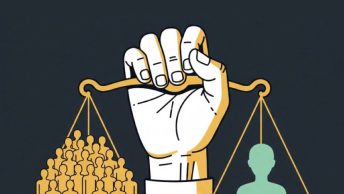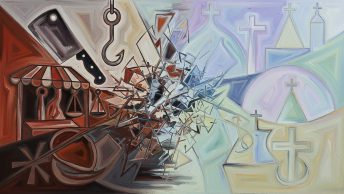A recent judgment of the Madras High Court upheld the validity of an order by the President of India commuting the death sentences of three death row prisoners to life imprisonment, with the condition that they would remain in prison for the rest of their lives. This judgment is symptomatic of the growing trend towards longer and harsher punishments, as constitutional courts and the President resort to such sentences with increasing regularity. At the level of sentencing policy, it marks a departure from a reform based understanding of punishment, towards the realm of pure retribution.
This post attempts to understand the legality of substituting the death sentence with this new form of life imprisonment. It argues that the Madras High Court’s judgment is premised upon suspect reasoning in the manner in which it draws a parallel between the judiciary and the executive’s power to pass such a sentence. This post further argues that the effect of such an order by the President is to impinge upon the constitutional powers of the Governor, as well as disrupt the federal balance of powers between the Centre and the state in matters of execution and supervision of sentence.
Judicial and Executive Power of Commutation of Sentences
The Presidential order in question states that he “has been pleased to commute the sentence of death awarded to condemned prisoners …to life imprisonment with the condition that the prisoners shall remain in prison for the whole of the remainder of their natural lives and there shall be no remission of the term of imprisonment.”
This condition attached to the commutation was challenged before the Madras High Court. In examining this, the Madras High Court drew an equivalence between the Supreme Court’s powers as understood in Sriharan’s case where the legality of full life without remission sentences was upheld; and the President’s powers under Article 72 of the Constitution. This approach appears to be erroneous as it overlooks two important distinctions between judicial and executive powers of commutation of the death sentence. First, the former is the result of a judicial exercise after weighing all the pros and cons and hearing the prisoner, whereas the latter is the culmination of an executive process shrouded in secrecy. Secondly, it is settled law that even a conditional whole life sentence imposed by the Supreme Court cannot restrict the exercise of constitutional clemency powers under Articles 72 and 161 leaving open avenues for review of the punishment after judicial determination. The President’s order as upheld by the Madras High Court’s decision however means that the President can unilaterally and absolutely bar the release of prisoners divesting the powers of any other executive constitutional or statutory authority.
Parallel powers of the Governor
Within the constitutional structure, the Governor and the President are the heads of the State and Union executive respectively. Ordinarily their clemency powers do not overlap – they extend to all matters to which the executive powers of the State or the Union respectively extend. However, in death sentence cases, their powers are concurrent. (See Union of India v Sriharan para 16, Lalit J. It must also be noted that Lalit, J. authored a separate opinion, concurring with the majority on all findings except on the issue of the power of the Supreme Court to impose a sentence of imprisonment for life without remission.) Article 72(3) makes it explicit that the powers of the Governor “under any law” in force are not affected. As in the present case, the denial of the mercy petition by the Governor does not mean that the President cannot allow the mercy. By virtue of Article 72(3), the reverse must also be true. However, the condition in the President’s order that “there shall be no remission” in effect renders the powers of the Governor under Article 161 nugatory.
This assumes importance since it is settled law that multiple petitions may be made to constitutional authorities as Articles 72 and 161 for plenary sovereign powers. (See: G Krishta Goud v. State of Andhra Pradesh, State of Harayana v Jagdish) The constitution bench in Sriharan specifically held that after the powers under Articles 72 and 161 were invoked, a prisoner could file subsequent petitions including those invoking statutory powers as under Section 432 of the Criminal Procedure Code, 1973). Given this legal position, the Presidential condition becomes paradoxical in as much as the plenary power cannot restrict itself. Since the condition limits the otherwise absolute powers, it is vitiated by self-denial.
Explaining the underlying reason for multiple petitions being allowed, Lalit, J. in his opinion in Sriharan, acknowledged that a prisoner’s condition is not static, and circumstances may change over a period of time, warranting a possibility of reviewing the sentence. For instance, factors pertaining to the prisoner such as terminal illness, acts of valour during incarceration, or reformation, or changes in political dispensation, and changing societal outlook towards questions of crime and punishment could be relevant circumstances.
The constitutional scheme of wide clemency powers then allows for a prisoner to request a review of their continued incarceration even if a previous request was declined. Such a scheme would be consistent with recent trends in international human rights jurisprudence also. The European Court’s jurisprudence allows for life term sentences; however, these must be reviewable and the term of imprisonment reducible. If the imprisonment becomes irreducible, whether de jure or de facto, there would be a violation of Article 3 which prohibits inhuman and degrading treatment. (See: Vinter and Others v. the United Kingdom [GC], nos. 66069/09, 130/10, and 3896/10, ECtHR 2013, 2013) The Madras High Court does not engage with this aspect and ignores the holding in Sriharan which allows for the clemency process to be invoked even when courts impose restrictions on the grant of remission.
Federalism
The condition also disturbs the balance of powers between the Centre and the states. The division of executive powers between the Centr and the states is such that the states have executive powers over matters covered by the state and concurrent list of the constitution (Article 162). The powers of the union executive extend only to the union list (Article 73(1) proviso). The clemency powers of the President extend to “an offence under any law relating to a matter to which the executive power of the Union extends” and to death sentence cases. As held by Lalit J. in Sriharan, the offence under S. 302 IPC (as in the present case) is directly relatable to the state list (Entry 1 – public order). Thus the grant of statutory remission for cases under section 302 is within the exclusive domain of the state government.
The concurrent clemency jurisdiction under Articles 72 and 161 applies only when the sentence of death is in play. Once commuted, the appropriate authority to decide on remission is solely the state executive. Therefore, while the President has powers to commute a sentence from death to imprisonment for life, even in a case under section 302, they do not have the power to restrict the grant of remission in the future after the commutation. The President can therefore neither impinge upon the constitutional powers of the Governor under Article 161 nor the statutory powers of the state government under S. 433 of the CrPC. These powers are exclusively the domain of the state government.
Issues of delay
The Madras High Court does not engage in reviewing the process that led to the President’s decision. The judgment does not show that the court looked at the materials that were placed before the President, with the result that it ignores the important issue of delay in deciding the mercy petitions. The judgment holds “that the petitioners would have gone to gallows, if not for a clemency granted by the President of India wherein the sentence was commuted to one of life imprisonment without the benefit of remission.” This however is speculative at best as it ignores the egregious delay of around 12 years in deciding the prisoners’ mercy petitions.
The judicial proceedings in the Supreme Court for these prisoners had concluded in 1999. The President decided the mercy petitions in 2012. During this long period of over 12 years, the prisoners continued to remain on death row. In adjudicating on a related issue, a three judge bench of the Supreme Court in Shatrughan Chauhan declared such long delays, in no uncertain terms, to amount to torture and a violation of Article 21. The remedy crafted by the Supreme Court is to commute the sentence from death to imprisonment for life. Given these facts, it was improper for the Madras High Court assume that but for the President’s commutation these prisoners would have faced certain execution.
Conclusion
The judgment of the Madras High Court allows one constitutional authority (the President) to impinge upon the domain of another concurrent constitutional authority (the Governor) and obfuscates the boundaries between the Centre and the state within which our sentencing policy operates. The Supreme Court has consistently found constitutional clemency powers to be “of the widest amplitude” (See: Kehar Singh) such that they are “untouchable and unapproachable” even by any legislature. (See: Joginder Singh and Maru Ram). As these sentences become more frequent, it will be interesting to see how the Supreme Court reconciles its own jurisprudence with the questions raised by such Presidential orders.








Thanks for sharing. I read many of your blog posts, cool, your blog is very good.
Your point of view caught my eye and was very interesting. Thanks. I have a question for you.